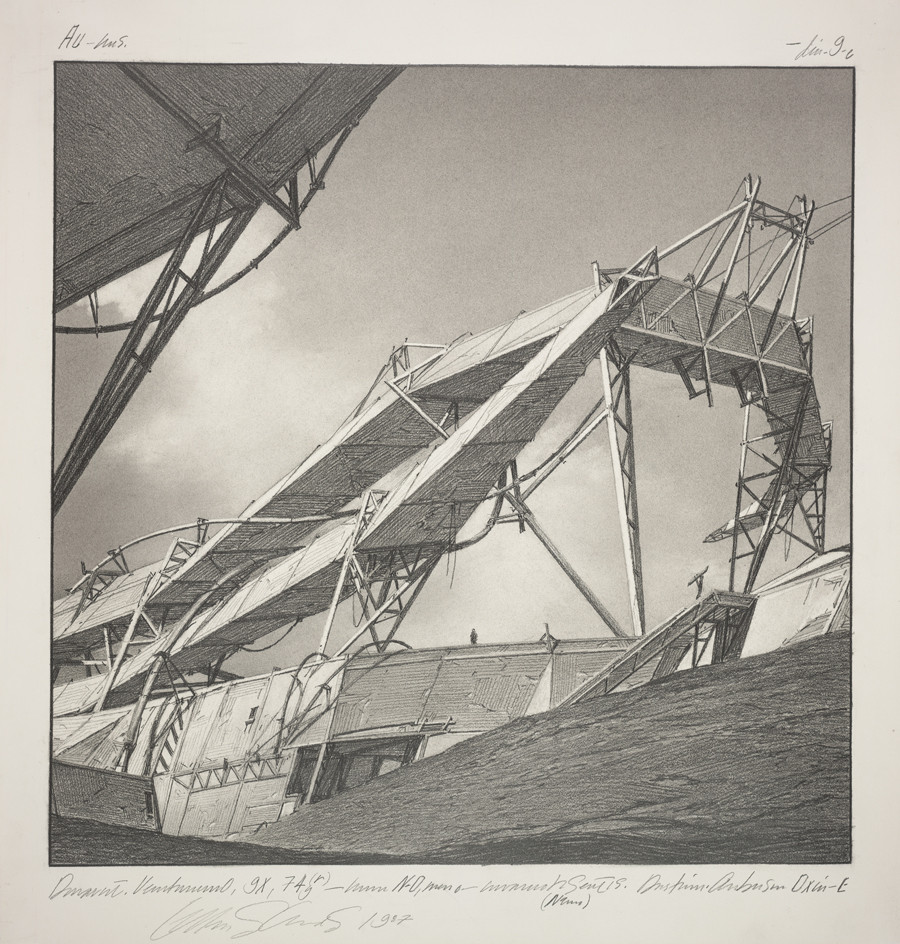In this video from our friends at Spirit of Space, Daniel Libeskind talks about his installation for the Venice Pavilion at the 2014 Venice Biennale, entitled 'Sonnets in Babylon'. The installation deals with drawing, an act that Libeskind believes is "the foundational art, and the mystery and the magic of all buildings and cities." To Libeskind, drawings are akin to religious materials, communicating meaning without the use of a fixed language and each with its own power to shape the way we understand the world around us. At the end he gives a hint as to why he is so attached to drawings: "I drew for many years before I even built a building. But I based those buildings that I built on the drawings I made... Every drawing is also a tool for the future."
Drawing: The Latest Architecture and News
VIDEO: Daniel Libeskind on Drawing, Architecture's Forgotten Fundamental
Sverre Fehn’s Drawings for Venice's Nordic Pavilion To Be Exhibited in Oslo

Norwegian architect and Pritzker Laureate Sverre Fehn’s original drawings for the Nordic Pavilion in Venice are to be presented alongside Ferruzzi’s monochromatic photographs of the building in an exhibition at the National Museum of Architecture in Oslo. Venice: Fehn’s Nordic Pavilion documents the incredible task undertaken by Fehn who, at the age of thirty-four, won the competition to design the pavilion and subsequently won international acclaim when the building was completed in 1962.
"Lebbeus Woods - Architect" Returns to NYC

This summer, the drawings, theories and works of architect Lebbeus Woods are headed to the city that Lebbeus considered home. After a five-month stay at SFMOMA, the exhibit "Lebbeus Woods - Architect" will be at the Drawing Center in SoHo, Manhattan until mid-June. The following story and overview of the exhibition, by Samuel Medina, originally appeared at Metropolis Magazine as “Coming Home".
It’s all too biblical an irony that Lebbeus Woods—architect of war, catastrophe, and apocalyptic doom—died as strong winds, rain, and waves barreled down on Manhattan, his home for some 40-odd years. Woods passed the morning after Hurricane Sandy flooded Lower Manhattan, almost as if the prophet had succumbed to one of his turbulent visions. But this apocryphal reading is just one way to view Woods’s work, which, as often as it was concerned with annihilation, always dared to build in the bleakest of circumstances.
Le Corbusier, Antoine de Saint-Exupéry, and Their Flights of Fancy
.jpg?1391552166)
This article by Avinash Rajagopal, originally published in Metropolis Magazine as 'The Little Prince' and Le Corbusier investigates the link between Le Corbusier and Antoine de Saint-Exupéry, writer of The Little Prince.
On October 22, 1929, a French architect got on the inaugural flight of the Aeroposta Argentina, a pioneering airline service that flew from Buenos Aires to Asuncion del Paraguay, flown by a French co-pilot. The act of flying would deeply influence the creative output of both passenger and pilot.
The former, of course, was Le Corbusier. The latter was Antoine de Saint-Exupéry, later to be famous as the creator of The Little Prince (1943), the well-beloved tale of a planet-hopping, fox-befriending, flower-loving space child.
Read on after the break for more about the pair
Drawing Shadows by Gautam Bhatia

Gautam Bhatia is an architect based in New Delhi and one of the most well-known architectural writers in India, having written for The New York Times, Outlook magazine and Indian Express.
We live today the way we do because we know no other. Our lives fit the defined patterns of homes, streets, neighborhoods, cities. As an architect I try to understand and explore - through drawing - different possibilities of building and landscape. More and more, drawing has taken me away from the conventions of architecture, into more abstract realms. Drawing has helped define space as it doesn’t exist, and perhaps as it should. Not in a utopian way, but one that tries merely to describe a different way we may live.
Ten Spectacular Drawings Win RIBA's "Eye Line" Competition

The results of RIBA Journal's recent drawing competition, Eye Line, are in. Top of the pile was Tom Noonan's drawing "Reforestation of the Thames Estuary," part of his Master's Thesis project at the Bartlett School of Architecture; however, the range of styles and content mean that there's something for everyone in the top ten. Read the full article and see all the drawings here.
All the Buildings in New York...Drawn by Hand

ALL THE BUILDINGS IN NEW YORK is a blog, a book, and, above all, illustrator James Gulliver Hancock's love letter to New York City.
As his website reveals, Hancock "panics that he may not be able to draw everything in the world… at least once." Since Kindergarten, he's been obsessed with drawing in meticulous detail (or, as he tells the Atlantic Cities, with a mix of "technicality and whimsy"), a characteristic this native Australian brought with him when he moved to Brooklyn, New York.
What began as a blog, All The Buildings In New York, to keep track of his many sketches of New York's architecture (particularly the brownstones), is now a book (All The Buildings in New York: That I've Drawn So Far - which includes about 500 drawings). Organized by neighborhoods, it features New York architectural icons from the past and present, including the Chrysler Building, the Flatiron, Apple's 5th Avenue store, as well as the everyday buildings that make up New York's unique cityscape.
See more images from All the Buildings in New York, after the break...
Michael Graves: In Defense of Drawing

In his Op-Ed for The New York Times, called “Architecture and the Lost Art of Drawing,” American architecture legend Michael Graves laments the loss of drawing in our computer-dependent age. While Graves realizes the usefulness of computer technology to present a final product, he maintains that the act of sketching (particularly those first, fleeting “referential sketches”) is vital to the process of design:





